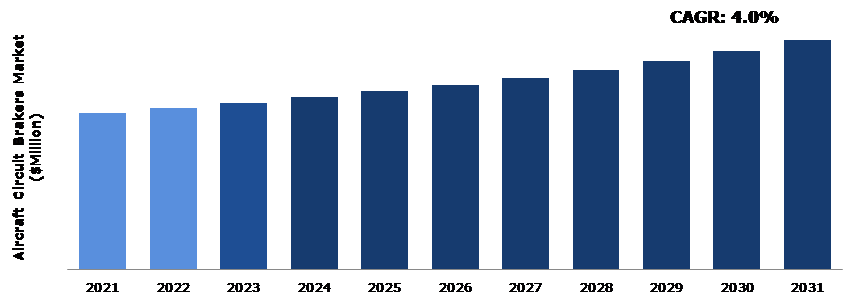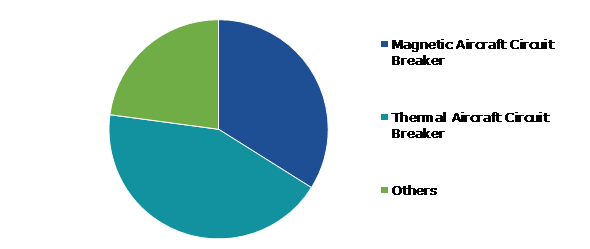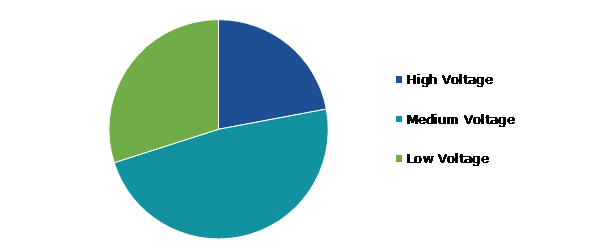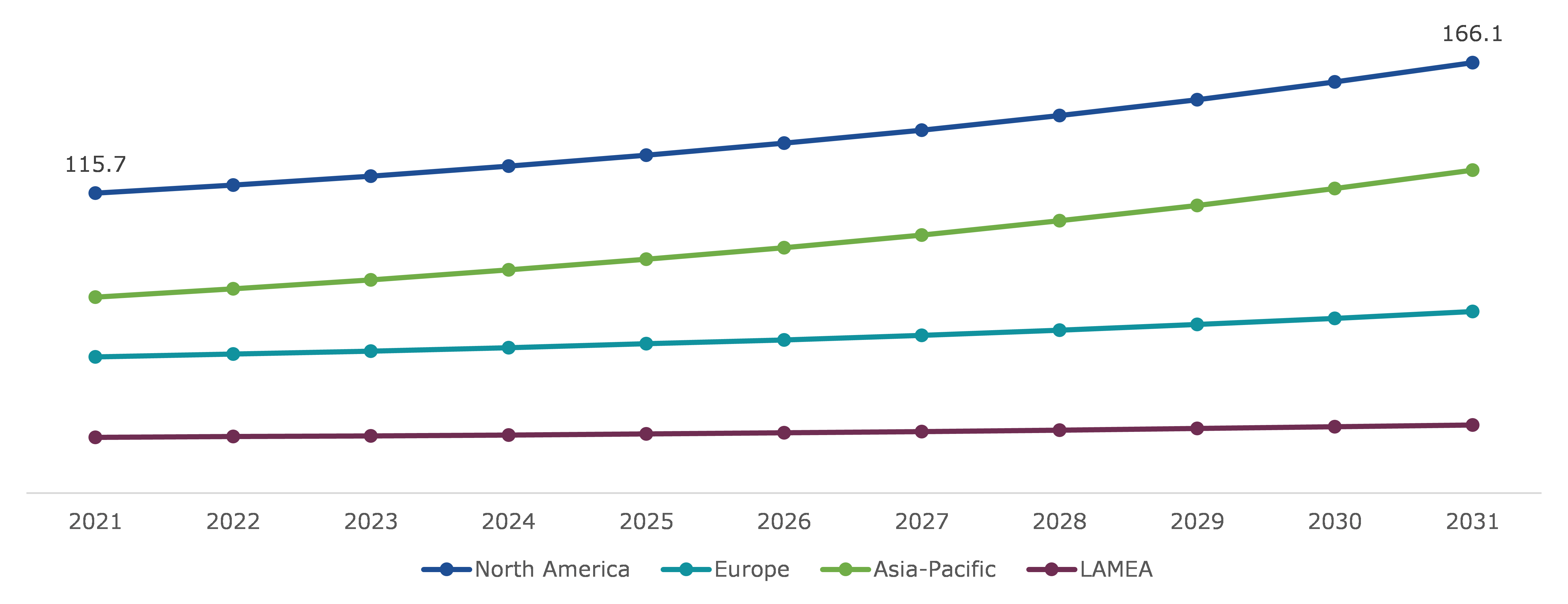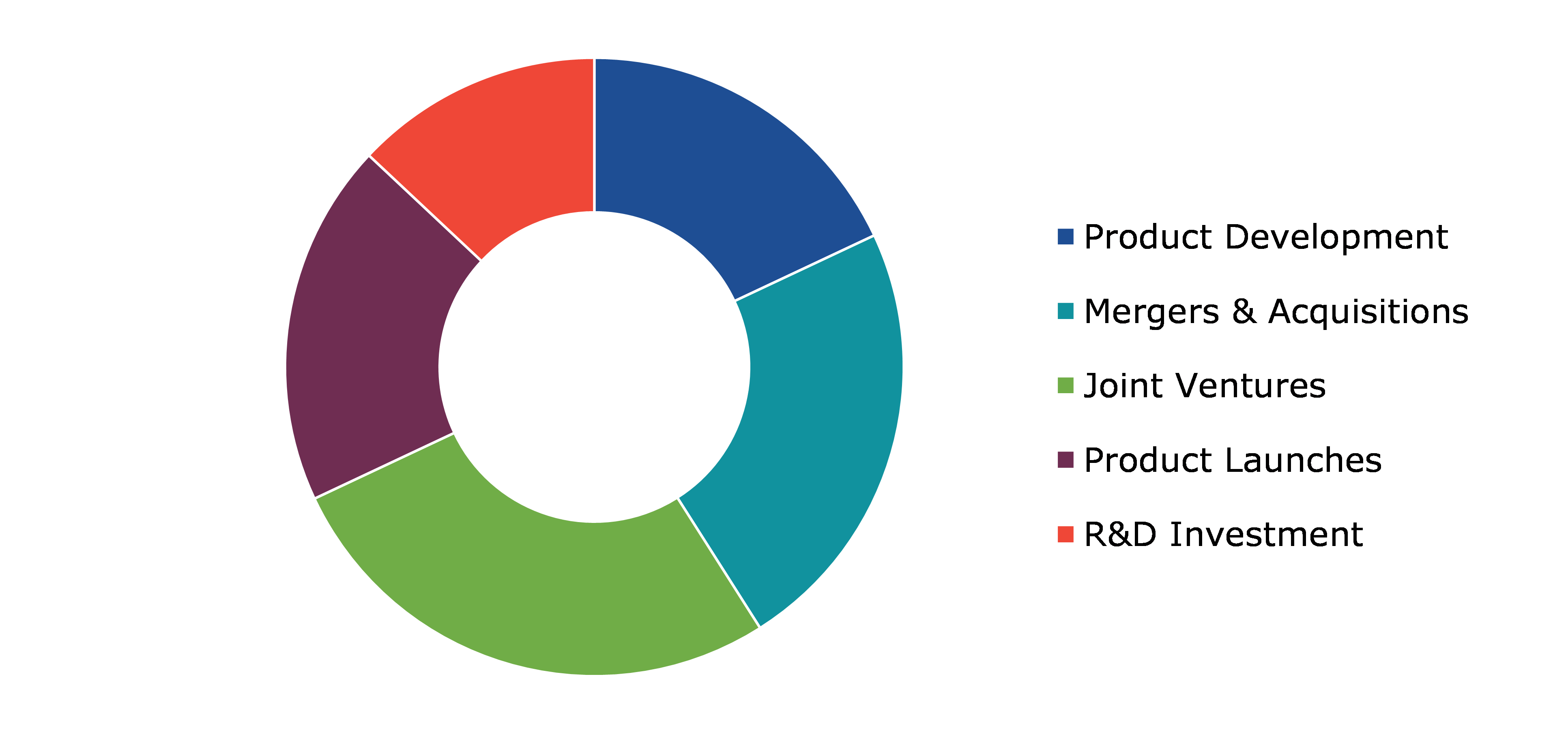Aircraft Circuit Breakers Market Report
RA08600
Aircraft Circuit Breakers Market by Type (Magnetic Aircraft Circuit Breaker, Thermal Aircraft Circuit Breaker, and Others), System Type (AC and DC), Voltage (High Voltage, Medium Voltage, and Low Voltage), Application (Commercial Aircraft, Military Aircraft, UAV, and Others), and Regional Analysis (North America, Europe, Asia-Pacific, and LAMEA): Global Opportunity Analysis and Industry Forecast, 2022-2031
Global Aircraft Circuit Breakers Market Analysis
The Global Aircraft Circuit Breakers Market Size was $265.3 million in 2021 and is predicted to grow with a CAGR of 4.0%, by generating revenue of $387.1 million by 2031.
Global Aircraft Circuit Breakers Market Synopsis
Aircraft circuit breakers are a crucial component of the electrical system as they guard against damage from high currents and prevent accidents. The circuit breakers used in aircraft pose no fire risk, require less maintenance, are small in size, and have a greater speed. Airplane circuit breakers play a crucial role in ensuring the grid works safely due to their ability to spot errors caused by power transmission system short circuits. As more people use renewable energy sources, the use of circuit breakers is rising. These factors are anticipated to boost the aircraft circuit breakers market growth in the upcoming years.
The circuit breakers deployed in the aircraft have high installation cost and requires regular maintenance. Also, circuit breakers are more expensive than a fuse. These factors are anticipated to restrain the aircraft circuit breakers market size during the forecast period.
The growing demand for efficient and reliable power supply in aircraft is anticipated to drive the aircraft circuit breakers market share in the upcoming years. This is because aircraft circuit breakers play a vital role in power distribution from high-voltage power produced at substations to lower voltages that are deployed in aircraft. Hence, circuit breakers can consistently deliver efficient power from with reliable transmission and distribution network. The circuit breakers offer consistent electricity that can ensure issues related to sudden voltage drops and power outages. These factors are anticipated to drive the aircraft circuit breakers market opportunity during the forecast period.
According to regional analysis, North America accounted for the highest share of the aircraft circuit breakers market in 2021. This growth is majorly owing to the presence of leading aircraft circuit breaker manufacturers namely Amphenol Corporation, AMETEK, Inc., GE Aviation, and Astronicas Corporation.
Aircraft Circuit Breakers Market Overview
Circuit breakers for aircraft are recognized as crucial components in the electrical systems of military aircraft. Such circuit breakers' designs can have contactor and switching features. The circuit breakers must be designed to operate under the extremely strict conditions required for military aircraft operations. Short-circuit protection is the main purpose of two manual and remote-control circuit breakers. It is not quite apparent whether military aircraft require motor protection. It may be preferable to operate the motor until it fails rather than stopping it at a safe temperature or load value because several motor functions are essential for the operation of the aircraft.
COVID-19 Impact on Global Aircraft Circuit Breakers Market
Most industries across the world have been negatively impacted due to the COVID-19 pandemic. Significant disruptions were experienced by respective manufacturing and supply-chain operations as a result of various precautionary lockdowns, as well as other restrictions that were enforced by governing authorities across the globe. Moreover, consumer demand has also subsequently reduced as individuals are now focusing on eliminating non-essential expenses from their respective budgets as the general economic status of most individuals has been severely affected by this outbreak. However, as respective governing authorities begin to lift these enforced lockdowns, the global aircraft circuit breakers market is expected to recover accordingly. The COVID-19 pandemic and containment efforts have drastically reduced demand for passenger air travel (and freight, to a lesser extent), endangering the survival of many businesses in both the air transport sector and the rest of the aviation industry and putting several jobs at risk. The ongoing crisis related to sustainability in the aviation value chain necessitates interdisciplinary coordination among the circuit breaker manufacturers and the aviation industry that will help the market growth post-pandemic.
Increase in the Use of Aircraft Circuit Breakers in the Industrial and Commercial Sector to Boost the Market Growth
The need for renewable energy sources is increasing in the aircraft sector which is used to limit electric power consumption. Circuit breakers are widely used in aircraft due to their benefits such as high performance, durability, ease of installation, and maintenance. In the absence of a circuit breaker, an anomalous or extremely high current may flow through the aircraft's electrical equipment and power network during an electrical issue, ultimately breaking the aircraft's electrical equipment. In the aviation industry, circuit breakers are widely deployed to protect electrical machinery, transformers, capacitors, generators, and other equipment from short circuits, over or under voltage, over or under frequency, reverse power, ground faults, and other problems. These factors are anticipated to boost the aircraft circuit breakers industry demand in the upcoming years.
To know more about global aircraft circuit breakers market drivers, get in touch with our analysts here.
Increase in Competition from the Unorganized Sector Hinders the Market Growth
An increase in investment in new advanced technologies has enabled the major players to compete in the global market. Rise in competition from unorganized companies to satisfy the demands from the industrial sectors such as manufacturing, processing, transportation, and construction is expected to be a significant factor that hinders the aircraft circuit breakers market growth. In addition, the SF6 circuit breaker has been identified as a greenhouse gas emitter, and numerous nations have placed safety standards and regulations on this breaker. These factors are anticipated to hamper the aircraft circuit breakers market demand in the upcoming years.
Growing Demand for Advanced Power Management Systems to Generate Better Growth Opportunities
The significant rise in the electrical load requirements and complex power generation platforms have increased the demand for circuit breakers in the aircraft sector. In the aircraft sector, the circuit breakers offer reliable and quick turn-ons and offloads without the aviator's help. Also, a rise in software-configurable circuit breakers that helps in building intelligent power management systems is on the rise across the aerospace sector. Currently, to ensure the safety of aircraft and to prevent mishaps related to overload and device failures, the distribution of electrical power is offered by electromechanical relays. These power management systems in aircraft, use circuit breakers as they respond quickly compared to fuses and offer reliability. These factors are anticipated to generate excellent growth opportunities in the aircraft circuit breakers market in the upcoming years.
To know more about global aircraft circuit breakers market opportunities, get in touch with our analysts here.
Global Aircraft Circuit Breakers Market, by Type
Based on type, the market has been divided into magnetic aircraft circuit breaker, thermal aircraft circuit breaker, and others. Among these, the thermal aircraft circuit breaker sub-segment accounted for the highest market share in 2021, whereas the magnetic aircraft circuit breaker sub-segment is estimated to witness the fastest growth during the forecast period.
Global Aircraft Circuit Breakers Market Share, by Type, 2021
Source: Research Dive Analysis
The thermal aircraft circuit breakers sub-segment accounted for a dominant market share in 2021. Thermal aircraft circuit breakers are electrical switches that function automatically and guard against circuit overcurrent. These circuit breakers work in a simple manner; to protect circuits from overcurrent, they use two switching mechanisms an electromagnet and a bimetallic strip. The height, duration, and ambient temperature of the overload current all affect the thermal circuit breakers' trip times. Higher current ratings heat the bimetal or hot wire until the specified trip time is reached.
The magnetic aircraft circuit breakers sub-segment is anticipated to witness the fastest growth during the forecast period. A magnetic circuit breaker is a safety device that is designed to cut an electrical current in the case of a power surge, thereby saving electrical equipment and electronics from harm. Circuit overload, loose, or damaged wiring and lightning can all cause the circuit breaker to trip. The magnetic aircraft circuit breaker is widely used for the safe operation of aircraft functions such as power-to-flight instruments, communication systems, navigation systems, and aircraft performance instruments.
Global Aircraft Circuit Breakers Market, by System Type
Based on system type, the market has been divided into AC and DC. Among these, the AC sub-segment accounted for the highest revenue share in 2021.
Global Aircraft Circuit Breakers Market Share, by System Type, 2021
Source: Research Dive Analysis
The AC sub-segment accounted for a dominant market share in 2021. A circuit breaker is an overcurrent protection device (OCPD) that is used to safeguard electrical devices and people from overcurrent circumstances. Circuit breakers, unlike most fuses, may be reset, making them a popular choice for overcurrent protection. Circuit breakers employ a bimetallic switch or an electromagnet to identify an overcurrent condition. AC circuit breakers stand for alternating currents. AC circuit breakers are more commonly used compared to DC circuit breakers as AC circuit breakers can effectively handle the changes in voltage because electrons are more relaxed and they can flow back and forth. To prevent the wiring system from overheating, the circuit cuts itself off from the main power source when excessive current is detected. Hence, AC circuit breakers are widely used for long-distance power transmission. These factors are projected to boost the AC sub-segment market share in the upcoming years.
Global Aircraft Circuit Breakers Market, by Voltage
Based on voltage, the market has been divided into high voltage, medium voltage, and low voltage. Among these, the medium voltage sub-segment accounted for the highest revenue share in 2021.
Global Aircraft Circuit Breakers Market Share, by Voltage, 2021
Source: Research Dive Analysis
The medium voltage sub-segment accounted for a dominant market share in 2021. Medium voltage breakers are made to be electrically actuated by a closing solenoid or a mechanism that uses stored energy. The main application of the manual process is breaker maintenance. Only low-voltage circuit breakers (600V and below) are made with manual operation as their main way of closing and tripping. Air-magnetic, SF6, or vacuum-type medium voltage circuit breakers are made to function electrically. In order to charge, close, and open the breaker, these electrical components drive cams, wheels, rollers, and latches.
Global Aircraft Circuit Breakers Market, by Application
Based on application, the market has been divided into commercial aircraft, military aircraft, UAVs, and others. Among these, the commercial aircraft sub-segment accounted for the highest revenue share in 2021.
Global Aircraft Circuit Breakers Market Share, by Application, 2021
Source: Research Dive Analysis
The commercial aircraft sub-segment accounted for a dominant market share in 2021. An airplane used for commercial purposes is one that flies passengers or freight between locations. There is an increase in demand for commercial aircraft from developed and developing countries to cater to the need of people for a better and faster mode of transport. Also, aircraft manufacturing companies are focusing on increasing their manufacturing capacity including the A320 family, A220, and B737Max is increasing. These factors are driving up demand in the aircraft circuit breaker market for the commercial aircraft segment.
Global Aircraft Circuit Breakers Market, Regional Insights
The aircraft circuit breakers market was investigated across North America, Europe, Asia-Pacific, and LAMEA.
Global Aircraft Circuit Breakers Market Size & Forecast, by Region, 2021-2031 (USD Million)
Source: Research Dive Analysis
The Market for Aircraft Circuit Breakers in North America to be the Most Dominant
North America is anticipated to hold a significant market share for the aircraft circuit breakers market during the forecast period. The region is home to many aircraft manufacturers, owing to a strong supply chain network and exceptional technological skills. In addition, the primary objective of aerospace manufacturing firms and the aerospace industry is to develop goods and technologies that support atmospheric and space flight for both commercial and defense/military uses. The U.S.-based businesses are putting more of an emphasis on modernizing manufacturing and fostering innovation within already-existing businesses, which is projected to support the expansion of the aircraft circuit breakers market in the region.
Competitive Scenario in the Global Aircraft Circuit Breakers Market
Product launches and mergers & acquisitions are common strategies followed by the major market players. For instance, in October 2021, Schneider Electric introduced its new and enhanced PowerPacT Molded Case Circuit Breaker (MCCB) series. The new PowerPacT series can help to save time and resources while reducing risk, simplifying installation and maintenance, and providing scalable upgrades that help to future-proof to meet environmental regulations.
Source: Research Dive Analysis
Some of the leading aircraft circuit breakers market players are Boeing Company, Airbus SE, Embraer SA, Commercial Aircraft Corporation of China Ltd, Mitsubishi Aircraft Corporation Lockheed Martin Corporation, Raytheon Technologies Corporation, Textron Inc., Dassault Aviation, and General Dynamics Corporation.
| Aspect | Particulars |
| Historical Market Estimations | 2020 |
| Base Year for Market Estimation | 2021 |
| Forecast Timeline for Market Projection | 2022-2031 |
| Geographical Scope | North America, Europe, Asia-Pacific, and LAMEA |
| Segmentation by Type |
|
| Segmentation by System Type |
|
| Segmentation by Voltage |
|
| Segmentation by Application |
|
| Key Companies Profiled |
|
Q1. What is the size of the global aircraft circuit breakers market?
A. The size of the global aircraft circuit breakers market was over $265.3 million in 2021 and is projected to reach $387.1 million by 2031.
Q2. Which are the major companies in the aircraft circuit breakers market?
A. Boeing Company, Airbus SE, and Embraer SA are some of the key players in the global aircraft circuit breakers market.
Q3. Which region, among others, possesses greater investment opportunities in the near future?
A. North America possesses great investment opportunities for investors in the future.
Q4. What will be the growth rate of the Asia-Pacific aircraft circuit breakers market?
A. Asia-Pacific aircraft circuit breakers market is anticipated to grow at 3.8% CAGR during the forecast period.
Q5. What are the strategies opted by the leading players in the market?
A. Product launches and mergers & acquisitions are the two key strategies opted by the operating companies in the market.
Q6. Which companies are investing more on R&D practices?
A. Boeing Company, Embraer SA, and Airbus SE are the companies investing more on R&D activities for developing new products and technologies.
1.Research Methodology
1.1.Desk Research
1.2.Real time insights and validation
1.3.Forecast model
1.4.Assumptions and forecast parameters
1.5.Market size estimation
1.5.1.Top-down approach
1.5.2.Bottom-up approach
2.Report Scope
2.1.Market definition
2.2.Key objectives of the study
2.3.Report overview
2.4.Market segmentation
2.5.Overview of the impact of COVID-19 on Global Aircraft Circuit Breakers market
3.Executive Summary
4.Market Overview
4.1.Introduction
4.2.Growth impact forces
4.2.1.Drivers
4.2.2.Restraints
4.2.3.Opportunities
4.3.Market value chain analysis
4.3.1.List of raw material suppliers
4.3.2.List of manufacturers
4.3.3.List of distributors
4.4.Innovation & sustainability matrices
4.4.1.Technology matrix
4.4.2.Regulatory matrix
4.5.Porter’s five forces analysis
4.5.1.Bargaining power of suppliers
4.5.2.Bargaining power of consumers
4.5.3.Threat of substitutes
4.5.4.Threat of new entrants
4.5.5.Competitive rivalry intensity
4.6.PESTLE analysis
4.6.1.Political
4.6.2.Economical
4.6.3.Social
4.6.4.Technological
4.6.5.Environmental
4.7.Impact of COVID-19 on Aircraft Circuit Breakers market
4.7.1.Pre-covid market scenario
4.7.2.Post-covid market scenario
5.Aircraft Circuit Breakers Market Analysis, by Type
5.1.Overview
5.2.Magnetic Aircraft Circuit Breaker
5.2.1.Definition, key trends, growth factors, and opportunities
5.2.2.Market size analysis, by region
5.2.3.Market share analysis, by country
5.3.Thermal Aircraft Circuit Breaker
5.3.1.Definition, key trends, growth factors, and opportunities
5.3.2.Market size analysis, by region
5.3.3.Market share analysis, by country
5.4.Others
5.4.1.Definition, key trends, growth factors, and opportunities
5.4.2.Market size analysis, by region
5.4.3.Market share analysis, by country
5.5.Research Dive Exclusive Insights
5.5.1.Market attractiveness
5.5.2.Competition heatmap
6.Aircraft Circuit Breakers Market Analysis, by System Type
6.1.AC
6.1.1.Definition, key trends, growth factors, and opportunities
6.1.2.Market size analysis, by region
6.1.3.Market share analysis, by country
6.2.DC
6.2.1.Definition, key trends, growth factors, and opportunities
6.2.2.Market size analysis, by region
6.2.3.Market share analysis, by country
6.3.Research Dive Exclusive Insights
6.3.1.Market attractiveness
6.3.2.Competition heatmap
7.Aircraft Circuit Breakers Market Analysis, by Voltage
7.1.High Voltage
7.1.1.Definition, key trends, growth factors, and opportunities
7.1.2.Market size analysis, by region
7.1.3.Market share analysis, by country
7.2.Medium Voltage
7.2.1.Definition, key trends, growth factors, and opportunities
7.2.2.Market size analysis, by region
7.2.3.Market share analysis, by country
7.3.Low Voltage
7.3.1.Definition, key trends, growth factors, and opportunities
7.3.2.Market size analysis, by region
7.3.3.Market share analysis, by country
7.4.Research Dive Exclusive Insights
7.4.1.Market attractiveness
7.4.2.Competition heatmap
8.Aircraft Circuit Breakers Market Analysis, by Application
8.1.Commercial Aircraft
8.1.1.Definition, key trends, growth factors, and opportunities
8.1.2.Market size analysis, by region
8.1.3.Market share analysis, by country
8.2.Military Aircraft
8.2.1.Definition, key trends, growth factors, and opportunities
8.2.2.Market size analysis, by region
8.2.3.Market share analysis, by country
8.3.UAV
8.3.1.Definition, key trends, growth factors, and opportunities
8.3.2.Market size analysis, by region
8.3.3.Market share analysis, by country
8.4.Others
8.4.1.Definition, key trends, growth factors, and opportunities
8.4.2.Market size analysis, by region
8.4.3.Market share analysis, by country
8.5.Research Dive Exclusive Insights
8.5.1.Market attractiveness
8.5.2.Competition heatmap
9.Aircraft Circuit Breakers Market, by Region
9.1.North America
9.1.1.U.S.
9.1.1.1.Market size analysis, by Type
9.1.1.2.Market size analysis, by System Type
9.1.1.3.Market size analysis, by Voltage
9.1.1.4.Market size analysis, by Application
9.1.2.Canada
9.1.2.1.Market size analysis, by Type
9.1.2.2.Market size analysis, by System Type
9.1.2.3.Market size analysis, by Voltage
9.1.2.4.Market size analysis, by Application
9.1.3.Mexico
9.1.3.1.Market size analysis, by Type
9.1.3.2.Market size analysis, by System Type
9.1.3.3.Market size analysis, by Voltage
9.1.3.4.Market size analysis, by Application
9.1.4.Market size analysis, by Application Research Dive Exclusive Insights
9.1.4.1.Market attractiveness
9.1.4.2.Competition heatmap
9.2.Europe
9.2.1.Germany
9.2.1.1.Market size analysis, by Type
9.2.1.2.Market size analysis, by System Type
9.2.1.3.Market size analysis, by Voltage
9.2.1.4.Market size analysis, by Application
9.2.2.UK
9.2.2.1.Market size analysis, by Type
9.2.2.2.Market size analysis, by System Type
9.2.2.3.Market size analysis, by Voltage
9.2.2.4.Market size analysis, by Application
9.2.3.France
9.2.3.1.Market size analysis, by Type
9.2.3.2.Market size analysis, by System Type
9.2.3.3.Market size analysis, by Voltage
9.2.3.4.Market size analysis, by Application
9.2.4.Spain
9.2.4.1.Market size analysis, by Type
9.2.4.2.Market size analysis, by System Type
9.2.4.3.Market size analysis, by Voltage
9.2.4.4.Market size analysis, by Application
9.2.5.Italy
9.2.5.1.Market size analysis, by Type
9.2.5.2.Market size analysis, by System Type
9.2.5.3.Market size analysis, by Voltage
9.2.5.4.Market size analysis, by Application
9.2.6.Rest of Europe
9.2.6.1.Market size analysis, by Type
9.2.6.2.Market size analysis, by System Type
9.2.6.3.Market size analysis, by Voltage
9.2.6.4.Market size analysis, by Application
9.2.7.Research Dive Exclusive Insights
9.2.7.1.Market attractiveness
9.2.7.2.Competition heatmap
9.3.Asia-Pacific
9.3.1.China
9.3.1.1.Market size analysis, by Type
9.3.1.2.Market size analysis, by System Type
9.3.1.3.Market size analysis, by Voltage
9.3.1.4.Market size analysis, by Application
9.3.2.Japan
9.3.2.1.Market size analysis, by Type
9.3.2.2.Market size analysis, by System Type
9.3.2.3.Market size analysis, by Voltage
9.3.2.4.Market size analysis, by Application
9.3.3.India
9.3.3.1.Market size analysis, by Type
9.3.3.2.Market size analysis, by System Type
9.3.3.3.Market size analysis, by Voltage
9.3.3.4.Market size analysis, by Application
9.3.4.Australia
9.3.4.1.Market size analysis, by Type
9.3.4.2.Market size analysis, by System Type
9.3.4.3.Market size analysis, by Voltage
9.3.4.4.Market size analysis, by Application
9.3.5.South Korea
9.3.5.1.Market size analysis, by Type
9.3.5.2.Market size analysis, by System Type
9.3.5.3.Market size analysis, by Voltage
9.3.5.4.Market size analysis, by Application
9.3.6.Rest of Asia-Pacific
9.3.6.1.Market size analysis, by Type
9.3.6.2.Market size analysis, by System Type
9.3.6.3.Market size analysis, by Voltage
9.3.6.4.Market size analysis, by Application
9.3.7.Research Dive Exclusive Insights
9.3.7.1.Market attractiveness
9.3.7.2.Competition heatmap
9.4.LAMEA
9.4.1.Brazil
9.4.1.1.Market size analysis, by Type
9.4.1.2.Market size analysis, by System Type
9.4.1.3.Market size analysis, by Voltage
9.4.1.4.Market size analysis, by Application
9.4.2.Saudi Arabia
9.4.2.1.Market size analysis, by Type
9.4.2.2.Market size analysis, by System Type
9.4.2.3.Market size analysis, by Voltage
9.4.2.4.Market size analysis, by Application
9.4.3.UAE
9.4.3.1.Market size analysis, by Type
9.4.3.2.Market size analysis, by System Type
9.4.3.3.Market size analysis, by Voltage
9.4.3.4.Market size analysis, by Application
9.4.4.South Africa
9.4.4.1.Market size analysis, by Type
9.4.4.2.Market size analysis, by System Type
9.4.4.3.Market size analysis, by Voltage
9.4.4.4.Market size analysis, by Application
9.4.5.Rest of LAMEA
9.4.5.1.Market size analysis, by Type
9.4.5.2.Market size analysis, by System Type
9.4.5.3.Market size analysis, by Voltage
9.4.5.4.Market size analysis, by Application
9.4.6.Research Dive Exclusive Insights
9.4.6.1.Market attractiveness
9.4.6.2.Competition heatmap
10.Competitive Landscape
10.1.Top winning strategies, 2021
10.1.1.By strategy
10.1.2.By year
10.2.Strategic overview
10.3.Market share analysis, 2021
11.Company Profiles
11.1.Boeing Company
11.1.1.Overview
11.1.2.Business segments
11.1.3.Product portfolio
11.1.4.Financial performance
11.1.5.Recent developments
11.1.6.SWOT analysis
11.2.Airbus SE
11.2.1.Overview
11.2.2.Business segments
11.2.3.Product portfolio
11.2.4.Financial performance
11.2.5.Recent developments
11.2.6.SWOT analysis
11.3.Embraer SA
11.3.1.Overview
11.3.2.Business segments
11.3.3.Product portfolio
11.3.4.Financial performance
11.3.5.Recent developments
11.3.6.SWOT analysis
11.4.Commercial Aircraft Corporation of China Ltd
11.4.1.Overview
11.4.2.Business segments
11.4.3.Product portfolio
11.4.4.Financial performance
11.4.5.Recent developments
11.4.6.SWOT analysis
11.5.Mitsubishi Aircraft Corporation
11.5.1.Overview
11.5.2.Business segments
11.5.3.Product portfolio
11.5.4.Financial performance
11.5.5.Recent developments
11.5.6.SWOT analysis
11.6.Lockheed Martin Corporation.
11.6.1.Overview
11.6.2.Business segments
11.6.3.Product portfolio
11.6.4.Financial performance
11.6.5.Recent developments
11.6.6.SWOT analysis
11.7.Raytheon Technologies Corporation.
11.7.1.Overview
11.7.2.Business segments
11.7.3.Product portfolio
11.7.4.Financial performance
11.7.5.Recent developments
11.7.6.SWOT analysis
11.8.Textron Inc.
11.8.1.Overview
11.8.2.Business segments
11.8.3.Product portfolio
11.8.4.Financial performance
11.8.5.Recent developments
11.8.6.SWOT analysis
11.9.Dassault Aviation.
11.9.1.Overview
11.9.2.Business segments
11.9.3.Product portfolio
11.9.4.Financial performance
11.9.5.Recent developments
11.9.6.SWOT analysis
11.10.General Dynamics Corporation
11.10.1.Overview
11.10.2.Business segments
11.10.3.Product portfolio
11.10.4.Financial performance
11.10.5.Recent developments
11.10.6.SWOT analysis
Many times, either at home or at the workplace, there are unexpected electrical failures. If they are not promptly fixed, they can seriously harm the electrical infrastructure of the location, sometimes even resulting in hazardous accidents and fires that can have terrible consequences. The circuit breaker, which is the key element of a well-protected electrical system, is one of the numerous protective devices used in electrical installations to prevent these circumstances, including the fuse, the surge arrester, and the circuit breaker.
Circuit breakers are necessary to connect to power generation plants and switchyards. It is employed to control and protect the power supply. Without a circuit breaker, extremely high current may flow during an electrical fault or short circuit fault across the aircraft's electrical equipment and power network, potentially permanently damaging the equipment. It is mainly adopted by industries for the benefits of durability, high performance, ease of installation, and maintenance.
Any modern aircraft's electrical system, which controls everything from the lighting and avionics to the auxiliary fuel pump and engine starter motor, is crucial to its proper operation. Aircraft circuit breakers are primarily used to power up and shut off the high circuit. They are used for electrical machines, the protection of plants, capacitors, transformers, and generators against short circuits, over- or under voltage, over- or under frequency, earth faults, reverse power, and other faults. The global aircraft circuit breakers market is expanding at a rapid pace due to the rise in the use of aircraft circuit breakers in the aerospace industries.
Newest Insights in the Aircraft Circuit Breakers Market
The growing urbanization and increase in infrastructure services are driving the demand for reliable and secure power, thus boosting the need for circuit breakers. As per a report by Research Dive, the global aircraft circuit breakers market is expected to surpass a revenue of $387.1 million in the 2022–2031 timeframe. The North America aircraft circuit breakers market is expected to register foremost growth in the years to come. This is because the region has a huge presence of aircraft circuit breaker manufactures due to the availability of exceptional technological skills and a strong supply chain network in the region.
How are Market Players Responding to the Rising Demand for Aircraft Circuit Breakers?
Market players are greatly investing in pioneering research and inventions to cater for the rising demand for advanced power management systems. Some of the foremost players in the aircraft circuit breakers market are Airbus SE, Boeing Company, Commercial Aircraft Corporation of China Ltd., Embraer SA, Raytheon Technologies Corporation, Mitsubishi Aircraft Corporation, Lockheed Martin Corporation, Textron Inc., General Dynamics Corporation, Dassault Aviation, and others. These players are focused on planning and implementing tactics such as mergers and acquisitions, collaborations, innovative advances, and partnerships to attain a remarkable position in the global market. For instance:
- In January 2021, ABB India Ltd., the provider of engineering services and electrical equipment manufacturing, announced Formula DIN-Rail, a new collection of isolators, RCCBs (Residual Current Circuit Breakers), and miniature circuit breakers.
- In February 2021, ARPA-E, a government organization responsible for encouraging and supporting the growth of advanced energy technology, announced USD 10 million in funding for six initiatives under the CABLES (Connecting Aviation by Lighter Electrical Systems) programme. CABLES teams will design medium-voltage (> 10 KV) power distribution cables, circuit breakers, and connectors for fully electrical aircraft applications.
- In October 2021, Schneider Electric, a leading expert in automation and energy management, announced the launch of the PowerPacT circuit breaker series' next generation at the NECA Nashville.
COVID-19 Impact on the Global Aircraft Circuit Breakers Market
The unpredicted rise of the coronavirus pandemic in 2020 adversely impacted the global aircraft circuit breakers market. During the pandemic period, significant interruptions occurred in respective production and supply-chain operations as a result of strict lockdowns and other restrictions imposed by governing bodies around the world. Additionally, consumer demand for various products and services decreased as people concentrated on reducing non-essential costs from their budgets because the overall economic situation of a majority of public was negatively impacted by this pandemic. However, as various regulatory bodies and industries are striving to recuperate the incurred losses in the post-pandemic period, the global aircraft circuit breakers market is likely to improve in the upcoming years.
Personalize this research
- Triangulate with your own data
- Request your format and definition
- Get a deeper dive on a specific application, geography, customer or competitor
- + 1-888-961-4454 Toll - Free
- support@researchdive.com

